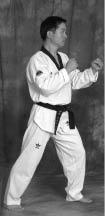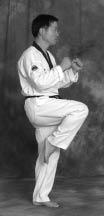Complete Kicking (5 page)
Authors: Turtle Press

• rear leg muscles: gluteus muscles in the buttock, hamstring
The abdominal and thigh muscles produce power for front kick, roundhouse kick, axe kick and side kick. The rear leg muscles generate force for back kick, whip kick and spin whip kick as well as jumping kicks.
developing abdominal muscles
The best exercises to develop strong abdominal muscles are sit-ups, including side and twisting sit-ups, crunches, V-ups, knee raises, leg raises, side leg raises and hanging leg raises.* Use a wide variety of exercises to be sure you are working the lower, mid, upper and oblique ab muscles. And don’t forget to include back strengthening exercises in your workout to develop a well-balanced torso musculature.
developing leg muscles
The best exercises to develop strong thigh and buttocks muscles are standing jumps, squats (with or without weight), lunges, sprinting, bounding, stair running and hill running.* Be sure to stretch at every workout so that your leg muscles do not become overly tight from strength training.
* For more information on the above exercises, see Ultimate Fitness Through Martial Arts, Sang H. Kim, Turtle Press.
sample kick strengthening workout*
Lunges, 10 reps, 1-3 sets
Squats, 10 reps, 1-3 sets
Crunches, 10 reps, 1-3 sets
Side sit-ups, 10 reps, 1-3 sets
V-ups, 5 reps, 1-3 sets
Alternating knee raise, 5 reps, 1-3 sets
Alternating leg raise, 5 reps, 1-3 sets
Double leg raise, 5 reps, 1-3 sets
Bench leg raise, 5 reps, 1-3 sets
50 yard sprint, 3 reps
50 yard uphill run, 3 reps
25 yard bounding, 3 reps
Stair run, 1 flight, 3 reps
Before Kicking...
1. warm up
Warm up before engaging in full-speed kicking to raise your body temperature and increase circulation. A good warm up enhances the ability of the muscles to contract and warm muscles stretch better. Begin with easy gross motor activities, gradually increasing in intensity from mild to vigorous. Control your movements while loading calculated stress on the muscles. Warm up for 15 minutes.
2. stretch
Before practice, always stretch your muscles to prepare them for the demands of kicking. Stretching increases the elasticity of the muscles, which enables you to have a greater range of motion and strength, and thus increases your capacity to generate more power. Stretching before kicking practice should include simple, dynamic exercises (see examples on page 41). This is different from the deep stretching that you do after practice to increase your flexibility. Stretch for 5-10 minutes.
3. breathe deeply
Deep breathing relaxes the muscles by providing ample oxygen to the cells. Deep belly breathing also enhances posture, circulation, relaxation and inner power. Consequently the mind becomes clear and the body works more efficiently. Deep breathing before practice eliminates the distractions of the body and mind and promotes mind-body unity. Breathe deeply for 3-5 minutes.
4. visualize
Visualization is active mental imagery to create familiarity with a specific target movement. For example, close your eyes and think of the beginning, middle and end of a side kick. Look closely at critical points such as pivoting your hip before impact. Replay it over and over until you get it right in your mind. Finally complete the entire sequence with a smooth and perfectly timed performance. Visualize one technique for 3-5 minutes.
warm-up options
Jumping jacks x 100
Push-ups x 50
Sit-ups x 100
Jump rope x 3 mins.
Running x 15 mins.
Dynamic leg raises
Hold the bar and raise your knee 10 times on each side, then swing your leg up, smoothly with control, 10 times on each side. This exercise develops kicking posture, precision and strength while warming up the kicking muscles.
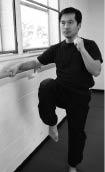
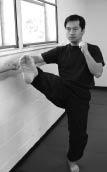
leg raise & hold
Hold the bar and raise your leg in a controlled kicking motion (left: whip kick, right: back kick) as high as you can and hold it for as long as you can. This will stretch and strengthen your leg muscles and develop balance and posture simultaneously.
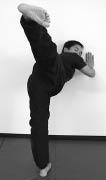
STRETCHING
There are two types of stretching: stretching as part of your warm-up, which is brief and dynamic, and stretching to develop flexibility (below), which is done after practice and can take up to 30 minutes.
Knockout Points
A knockout kick renders your opponent unconscious by either stopping the supply of oxygen and blood to the brain, causing insufferable pain or causing a shock to the brain.
MAJOR KNOCKOUT POINTS
1. Head: Kicks to the head can shock the brain and shut down the function of the nervous system. A kick to the jaw for instance causes a rebounding effect in the brain, momentarily nullifying the function of the nervous system, which renders the opponent unconscious.
2. Neck (Carotid Artery): Striking the carotid sinus can lead to a sudden drop in blood pressure and heart rate which can cause a loss of consciousness and, in some cases, death. Because striking the carotid sinus relies simply on triggering a physiological reaction, even a light strike can result in a knockout. Striking the neck is illegal in most combat sports.
3. Groin and 4. Pelvic Plexus: These targets are also generally not legal in combat sports, but are effective knockout targets for self-defense because they can be hit with a powerful low section kick.
5. Solar Plexus and 8. Cardiac Plexus: These two targets have to be struck with great force with a powerful kick like a side kick, to achieve a knockout. Kicking this area can also “knock the wind out of” an opponent.
6. Liver and 7. Kidneys (both sides): These three targets can be easily struck with roundhouse kick. Even if you don’t achieve a knockout, kicks to the liver or kidneys will weaken an opponent’s stamina and will.
9. Brachial Plexus: This target is vulnerable to an axe kick. If the plexus strike does not cause a knockout, it can result in serious damage to the clavicle bone.
FUNDAMENTAL KICKS
Kicking is one of the most fun and natural activities in the martial arts. This chapter has 12 fundamental kicks and for each kick you’ll find the purpose of the kick, key points to pay attention to, common targets, how-to, variations, applications specific to self-defense, traditional martial arts practice and combat sports, common mistakes and practice drills.
FRONT KICK
purpose
Front kick is used to strike a target that is directly in front of you. If your opponent is on your side or rear, simply turn your body in that direction and kick. Front kick is the most direct way to knock down an opponent by kicking the groin, face or neck. You can also use it to deter an advancing opponent by attacking the kneecap, shin or thigh.
key points
Bend your kicking knee acutely and snap the ball or instep of your foot quickly and powerfully to the target. If you are wearing shoes, kick with the toe or instep of your shoe. In a self-defense situation, aim for the middle of the body or leg to increase your chances of striking the target.
Striking area
Ball, instep, toes, bottom of the foot
targets
1. groin
2. lower abdomen
3. solar plexus
4. chest
5. neck
6. mouth
7. frontal thigh
8. kneecap
9. shin
how to
1. From fighting stance, shift your weight to the front leg.
2. Bring your knee up, pointing it at the target.
Other books
Tidal Wave by Arend, Vivian
On The Ropes by Cari Quinn
Black Fallen by Elle Jasper
The Hallowed Isle Book Four by Diana L. Paxson
Someone Elses Daughter by Jack Norman
Las mujeres casadas no hablan de amor by Melanie Gideon
A Good American by Alex George
Broken Angels by Harambee K. Grey-Sun
The Return of the Tycoon by Kate Lambert
Suite 269 by Christine Zolendz
